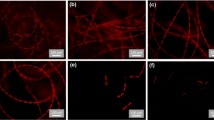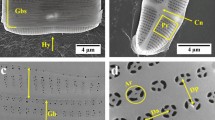Abstract
The eukaryotic diatoms are unicellular algae. They are well known for their filigree micro- and nanostructured cell walls which mainly consist of amorphous silica as well as various organic compounds. However, diatoms are also known to incorporate certain amounts of aluminium into their cell walls. Unexpectedly, enhanced Al concentrations in the Southern Yellow Sea were found to be correlated with a diatom spring bloom. Therefore, we have analyzed the influence of strongly enhanced Al concentrations in the culture medium upon the growth behaviour of the diatom Stephanopyxis turris (S. turris). The uptake and incorporation of Al into the cell walls was monitored. It turned out that S. turris survives aluminium concentrations up to 105.5 μM (2.85 mg/l) in the culture medium. Under the applied conditions, this corresponds to an Al/Si ratio of 1:1. These large amounts of Al had to be offered in the form of bis–tris-chelates in order to prevent uncontrolled precipitation. Under these conditions, the Al/Si ratio in the cell walls could be increased up to about 1:15 as determined by ICP-OES, the highest amount of aluminium found in diatom cell walls yet. Structural characterization of the biosilica by ATR-FTIR and solid-state 27Al NMR spectroscopy revealed that an amorphous aluminosilicate phase is formed where the aluminium exists as four- and sixfold-coordinated species.





Similar content being viewed by others
References
Azam F, Hemmingsen BB, Volcani BE (1973) Germanium incorporation into the silica of diatom cell walls. Arch Mikrobiol 92:11–20
Beck L, Gehlen M, Flank A-M, Van Bennekom AJ, Van Beusekom JEE (2002) The relationship between Al and Si in biogenic silica as determined by PIXE and XAS. Nucl Instr Methods Phys Res B 189:180–184
Beyer HK, Belenykaja IM, Hange F, Tielen M, Grobet PJ, Jocobs PA (1985) Preparation of high-silica faujasites by treatment with silicon tetrachloride. J Chem Soc 1(81):2889–2901
Brunner E, Richthammer P, Ehrlich H, Paasch S, Simon P, Ueberlein S, van Pée K-H (2009a) Chitin-based organic networks: an integral part of cell wall biosilica in the diatom thalassiosira pseudonana. Angew Chem Int Edit 48(51):9724–9727
Brunner E, Gröger C, Lutz K, Richthammer P, Spinde K, Sumper M (2009b) Analytical studies of silica biomineralization: towards an understanding of silica processing by diatoms. Appl Microbiol Biotechnol 84(4):607–616
Chester AW, Derouane EG (eds) (2009) Zeolite characterization and catalysis—a tutorial. Springer, Heidelberg
Chiappino ML, Azam F, Volcani BE (1977) Effect of germanic acid on developing cell walls of diatoms. Protoplasma 93:191–204
Chiovitti A, Harper RE, Willis A, Bacic A, Mulvaney P, Wetherbee R (2005) Variations in the substituted 3-linked mannans closely associated with the silicified walls of diatoms. J Phycol 41:1154–1161
Chou L, Wollast R (1997) Biogeochemical behavior and mass balance of dissolved aluminium in the western Mediterranean Sea. Deep-Sea Res Part II 44:741–768
Davis AK, Hildebrand M (2008) A self-propagating system for Ge incorporation into nanostructured silica. Chem Commun 37:4495–4497
Dixit S, van Cappellen P, van Bennekom AJ (2001) Processes controlling solubility of biogenic silica and pore water build-up of silicic acid in marine sediments. Mar Chem 73:333–352
Driscoll CT, Schecher WD (1990) The chemistry of aluminum in the environment. Environ Geochem Health 12(1–2):28–49
Ehrlich H, Simon P, Carrillo-Cabrera W, Bazhenov VV, Botting JP, Ilan M, Ereskovsky AV, Muricy G, Worch H, Mensch A, Born R, Springer A, Kummer K, Vyalikh DV, Molodtsov SL, Kurek D, Kammer M, Paasch S, Brunner E (2010) Insights into chemistry of biological materials: newly discovered silica-aragonite-chitin biocomposites in demosponges. Chem Mater 22(4):1462–1471
Ellwood MJ, Hunter KA (1999) Determination of the Zn/Si ratio in diatom opal: a method for the separation, cleaning and dissolution of diatoms. Mar Chem 66:149–160
Ellwood MJ, Hunter KA (2000) The incorporation of zinc and iron into the frustules of the marine diatom Thalassiosira pseudonana. Limnol Oceanogr 45(7):1517–1524
Falasco E, Bona F, Ginepro M, Hlúbikova D, Hoffmann L, Ector L (2009) Morphological abnormalities of diatom silica wall in relation to heavy metal contamination and artificial growth conditions. Water SA 35:595–606
Fung BM, Khitrin AK, Ermolaev K (2000) An improved broadband decoupling sequence for liquid crystals and solids. Magn Reson 142(1):97–101
Gal A, Hirsch A, Siegel S, Li C, Aichmayer B, Politi Y, Fratzl P, Weiner S, Addadi L (2012) Plant cystoliths: a complex functional biocomposite of four distinct silica and amorphous calcium carbonate phases. Chem Eur J 33:10262–10270
Gehlen M, Beck L, Calas G, Flank A-M, van Bennekom AJ, van Beusekom JEE (2002) Unraveling the atomic structure of biogenic silica: evidence of the structural association of Al and Si in diatom frustules. Geochim Cosmochim Acta 66(9):1601–1609
Harrison PJ, Waters RE, Taylor FJR (1980) A broad spectrum artificial sea water medium for coastal and open ocean phytoplankton. J Phycol 16:28–35
Heredia A, Figueira E, Rodrigues CT, Rodríguez-Galván A, Basiuk VA, Vrieling EG, Almeida SFP (2012) Cd2+ affects the growth, hierarchical structure and peptide composition of the biosilica of the freshwater diatom Nitzschia palea (Kützing) W Smith. Phycol Res 60:229–240
Hydes DJ, de Lange GJ, de Baar HJW (1988) Dissolved aluminium in the Mediterranean. Geochim Cosmochim Acta 52:2107–2114
Iler RK (1979) The chemistry of silica. Wiley, New York
Jaccard T, Ariztegui D, Wilkinson KJ (2009) Incorporation of zinc into the frustules of the freshwater diatom Stephanodiscus hantzschii. Chem Geol 265:381–386
Jeffryes C, Gutu T, Jiao J, Rorrer L (2008a) Two-stage photobioreactor process for the metabolic insertion of nanostructured germanium into the silica microstructure of the diatom Pinnularia sp. Biomimetic Supramol Syst 28(1):107–118
Jeffryes C, Gutu T, Jiao J, Rorrer L (2008b) metabolic insertion of nanostructered TiO2 into the patterned biosilica of the diatom pinnularia sp. by a two-stage bioreactor cultivation process. ACS Nano 2(10):2103–2112
Kröger N, Poulsen N (2008) Diatoms—from cell wall biogenesis to nanotechnology. Annu Rev Genet 42:83–107
Kröger N, Bergsdorf C, Sumper M (1996) Frustulins: domain conservation in a protein family associated with diatom cell walls. Eur J Biochem 239:259–264
Kröger N, Lorenz S, Brunner E, Sumper M (2002) Self-assembly of highly phosphorylated silaffins and their function in biosilica morphogenesis. Science 298:584–586
Kubelková L, Seidl V, Borbély G, Beyer HK (1988) Correlations between wavenumbers of skeletal vibrations, unit-cell size and molar fraction of aluminium of Y zeolites. J Chem SOC Faraday Trans 1 84(5):1447–1454
MacKenzie KJD, Smith ME (2008) Multinuclear solid-state NMR of inorganic materials. Pergamon, Oxford
Marchetti A, Cassar N (2009) Diatom elemental and morphological changes in response to iron limitation: a brief review with potential paleoceanographic applications. Geobiology 7:419–431
Martinez JR, Ruiz F, Vorobiev YV, Perez-Robles F, Gonzalez-Hernandez J (1998) Infrared spectroscopy analysis of the local atomic structure in silica prepared by sol-gel. J Chem Phys 109:7511–7514
Measures CI, Brown ET (1996) Estimating dust input to the Atlantic Ocean using surface water aluminium concentrations. In: Guerzoni S, Chester R (eds) The impact of desert dust across the Mediterranean. Kluwer, Dordrecht
Measures CI, Edmond JM (1990) Aluminium in the South Atlantic: steady state distribution of a short residence time element. J Geophys Res 95:5331–5340
Mugnaioli E, Natalio F, Schloßmacher U, Wang X, Müller WEG, Kolb U (2009) Crystalline nanorods as possible templates for the synthesis of amorphous biosilica during spicule formation. ChemBioChem 10:683–689
Qin T, Gutu T, Jiao J, Chang C-H, Rorrer GL (2008) Biological fabrication of photoluminescent nanocomb structures by metabolic incorporation of germanium into the biosilica of the diatom Nitzschia frustulum. ACS Nano 2(6):1296–1304
Ren J-L, Zhang G-L, Zhang J, Shi J-H, Liu S-M, Li F-M, Jin J, Liu C-G (2011) Distribution of dissolved aluminium in the Southern Yellow Sea: influences of a dust storm and the spring bloom. Mar Chem 125:69–81
Rorrer GL, Chang C-H, Liu S-H, Jeffryes C, Jiao J, Hedberg JA (2005) Biosynthesis of silicon-germanium oxide nanocomposites by the marine diatom Nitzschia frustulum. J Nanosci Nanotechnol 5(1):41–49
Round FE, Crawford RM, Mann DG (1990) The diatoms. Cambridge University Press, Cambridge
Sumper M, Brunner E (2006) Learning from Diatoms: nature’s tools for the production of nanostructured silica. Adv Funct Mater 16:17–26
Sumper M, Brunner E (2008) Silica biomineralisation in diatoms: the model organism Thalassiosira pseudonana. ChemBioChem 9:1187–1194
van Bennekom AJ, Buma AGJ, Nolting RF (1991) Dissolved aluminium in the Weddell-Scotia confluence and effect of Al on the dissolution kinetics of biogenic silica. Mar Chem 35:423–434
van Beusekom JEE, Weber A (1995) Der einfluß von aluminium auf das wachstum und die entwicklung von kieselalgen in der nordsee. Deutsche hydrographische Z Suppl 5:213–220
Wenzl S, Hett R, Richthammer P, Sumper M (2008) Silacidins: highly acidic phosphopeptides from diatom shells assist in silica precipitation in vitro. Angew Chem Int Ed Engl 47:1729–1732
Wesolowski DJ, Palmer DA, Begun GM (1990) Complexation of aluminate anion by bis–tris in aqueous media at 25–50°C. J Solut Chem 19:159–173
Acknowledgments
Financial support from the Deutsche Forschungsgemeinschaft (Br 1278/12 and Br 1278/17-1) and the Fonds der Chemischen Industrie is gratefully acknowledged.
Author information
Authors and Affiliations
Corresponding author
Additional information
Susanne Machill, Lydia Köhler and Susanne Ueberlein contributed equally to this study.
Rights and permissions
About this article
Cite this article
Machill, S., Köhler, L., Ueberlein, S. et al. Analytical studies on the incorporation of aluminium in the cell walls of the marine diatom Stephanopyxis turris . Biometals 26, 141–150 (2013). https://doi.org/10.1007/s10534-012-9601-3
Received:
Accepted:
Published:
Issue Date:
DOI: https://doi.org/10.1007/s10534-012-9601-3




